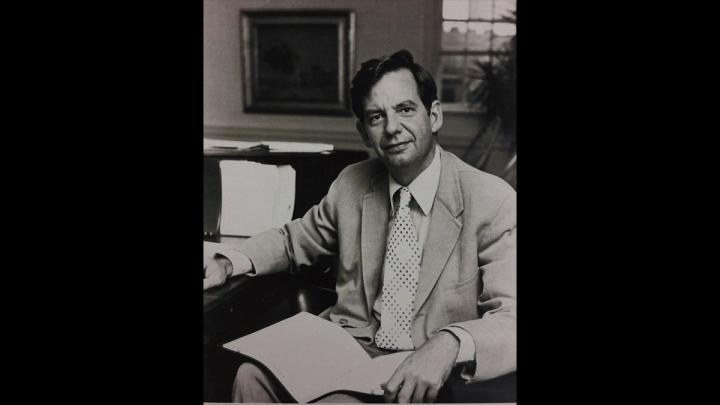What does it take to become a great higher education leader? The role is demanding: leading universities or similar philanthropic entities involves multiple constituencies, innumerable tasks, complex and often conflicting goals. Today, with higher education under unprecedented attack, it’s especially important to learn what we can from exemplars.
In this context, an account of the life of the late William (Bill) Bowen, LL.D. ’73, proves instructive. In the concluding decades of the twentieth century, he stood out as an excellent scholar, a university president who significantly strengthened an admired institution, an influential foundation leader who carried out important scholarly initiatives, and the “go to” authority on higher education issues and personnel.
Nancy Malkiel has written an excellent biography of this formidable figure. A historian and administrator at Princeton, she knew Bowen well for several decades, conducted more than 200 carefully documented interviews, and has sought to present a balanced view of a complex personality. But there are both advantages and disadvantages to a biographical account by an intimate.
Far more than most university presidents of his generation, Bowen’s early life is classic Horatio Alger. Raised in a small town in Ohio, with a salesman father who died young and a mother who struggled to raise the family, Bowen’s prospects were modest. But in high school he excelled as student and athlete; he was able to attend nearby Denison College on scholarship. Already exhibiting scholarly inclinations, Bowen was accepted to the doctoral program in economics at Princeton; once again, he stood out. With startling speed, he was hired by the economics department, became a star teacher, wrote insightfully about the economics of education and culture, and received tenure.
That was but the start. Bowen showed unusual interest in and talent for issues of governance. Working closely with then-President Robert Goheen, Bowen rose steadily in administrative ranks and soon participated in significant decisions. He spearheaded an important study of the relationship between universities and the federal government. Rethinking administrative roles, he delineated a smooth division of labor among the president, various deans, and the newly created role of provost. Clearly, he had the gift of “institutional intelligence.” When Goheen announced his intention to step down, Bowen, then just 38, was the almost universal choice as successor. He signaled (perhaps feigned) a lack of interest in the position but soon succeeded Goheen, leading Princeton from 1972 to 1988.
Bowen’s presidency was extremely successful. He had good ideas and worthwhile priorities; conferred and collaborated constructively with key individuals and constituencies; set up committees strategically composed of the various stakeholders and—by example—ensured that committee members did their work carefully and collaboratively. He sensed when a change of course was needed and knew when and how to decide and then move on to the next challenge or opportunity. He had boundless energy and stimulated others to work extremely hard while still retaining their affection. He hand-wrote substantive thank-you notes to everyone…often thanking those who had thanked him! He steadily improved the quality of the already excellent Princeton faculty—raiding peer schools for key appointments, especially in the humanities, and insisting on top scholars who also had leadership potential. He enabled the student body to be far more diverse, economically and demographically, opening it up smoothly to co-education (the subject of Malkiel’s earlier fine book, “Keep the Damned Women Out”: The Struggle for Coeducation), and providing comfortable residences which, like Harvard’s houses and Yale’s colleges, constituted an alternative to Princeton’s exclusionary “eating clubs.” Bowen dealt deftly with the tensions surrounding America’s involvement in the Vietnam War and, as was increasingly expected of presidents, raised significant funds for academic initiatives.
Indeed, the only area where—by his own admission—Bowen apparently fell short was in his effort to rapidly assemble a first-class faculty in microbiology. Princeton lacked a medical school, and courtesy appointments at the University of Pennsylvania did not suffice to attract and maintain top-flight investigators and teachers.
(An aside from one who has spent more than six decades at Harvard: As a Jewish boy growing up in Scranton, Pennsylvania, in the 1950s, I applied to four Ivy League schools—but not to Princeton. Perhaps unduly influenced by the writings of F. Scott Fitzgerald, I thought Princeton was too gentile and preppy. Three decades later, when I spent some days at Princeton, I realized that Princeton after Bowen was no longer mired in the Jazz Age. But it was still different from Harvard and Yale. Princeton was—and had remained—primarily a college, not a university, and that may limit its lessons for institutions that are larger and/or less selective.)
In 1988, at the height of his prominence in higher education, Bowen accepted the presidency of the Andrew W. Mellon Foundation. Though less well-endowed than the best-known philanthropies (Ford, Rockefeller), it had considerable assets that could be applied to the strengthening and diversification of higher education as well as related areas like the arts and culture.
Bowen hit the ground running and, as at Princeton, maintained a frenetic pace. He launched significant initiatives in the aforementioned (and other) areas. Rather than relying on individuals already in the sector (so-called philanthropoids), he attracted a senior staff of proven leaders in higher education and granted them considerable autonomy. With a keen eye for talent, he brought in young scholars (even undergraduates!) to whom he served as a mentor, role model, critical friend, and—invariably—recommender for the next position.
Networking and promoting were key facets of Bowen’s portfolio. Until 1988, his eyes had been squarely on Princeton—attracting, mentoring, and retaining talent by all available means. Once at Mellon, he broadened his perspective to higher education more broadly. Repeatedly, he ensured that talented individuals secured positions across the academic landscape. Even today, dozens of leading scholars and administrators—including Harvard presidents Neil Rudenstine (a dean and provost during Bowen’s Princeton years) and Lawrence Bacow—can be considered “offspring” of Bill Bowen.
Bowen steadily improved the quality of the already excellent Princeton faculty, and enabled the student body to be far more diverse.
Bowen was confident that he knew how to strengthen the sector. Using the copious resources of a major foundation, he led research initiatives in a score of areas. Best known is his collaboration with his close colleague, Harvard president Derek Bok; using data from more than 30 selective institutions, these widely respected leaders sought to ascertain and document the significant positive effects of affirmative action for the broader society. Their highly influential book, The Shape of the River, has become a standard reference—cited widely not only in scholarly texts but in legal briefs. (Read the magazine’s review, harvardmag.com/shape-river-98, and a twenty-fifth anniversary assessment at “Debating Diversity,” May-June 2019, page 21.)
Hard to believe that after Princeton, Bowen wrote or coauthored nearly a score of books on topics including strengthening the humanities; problematic facets of high-stake athletics; the advantages and costs of governance by faculty; and the promise of distance learning, including early studies of online education. Again, several have become standard references—and co-authors Bacow, Matthew Chingus, Sarah Levin, Michael McPherson, Rudenstine, James Shulman, and Eugene Tobin are now senior scholars in the field.
Finally, and not surprisingly, Bowen played a major role on the boards of directors of both for-profit and nonprofit organizations. Within higher education, he oversaw the launch of Ithaka, JSTOR, and ARTstor—pioneering efforts to make many decades of literary and artistic scholarship and artifacts widely available to researchers and educators. In the broader society, he served on the boards of American Express and Merck (among others). Making maximal use of these powerful positions, Bowen not only connected many people across diverse sectors but also played a prominent role in determining who ran—and who should not run—such entities.
Circa 2000, Bill Bowen was the archetypical “go-to” person.
Sadly, he did not find it easy to leave center stage. Although Malkiel’s accounting of the Princeton years is unfailingly positive, she presents some criticism of Bowen’s Mellon years and skepticism about his involvement in governance of various other entities. She chronicles the sad final years of his life, when he became ill, and his influence waned. Seated at a party, he complained to his wife, Mary Ellen, “I don’t understand, nobody’s coming to talk to me.”
And there is another facet to the human being behind the leader. Malkiel makes public a story that had been known for decades in the Princeton community. While president, Bowen carried on a long-term affair with an undergraduate. Asked pointedly to stop, he simply refused: this was his personal business, and that was that.
As biographer (and friend), Malkiel had the choice of ignoring the story altogether or making it the showstopper. She handles this authorial conundrum deftly—not mincing words, allowing the student (now a physician and parent) to testify, empathizing with Bowen’s widow and children, stressing that such inappropriate behavior would trigger instant termination in our time.
Nancy Malkiel has written an important and needed book, one that deserves to be widely read within the sector and beyond—when the demands on complicated institutions like research universities are nearly impossible to meet, and their leaders are challenged to raise funds, provide wise governance, scan and feed social media, and fulfill endless political and community agendas.
That said, her biography raises a number of issues.
First, what responsibilities does a leader have to strengthen the sector(s) in which he is a dominating figure? As president of Princeton and Mellon, Bowen gets high marks. Not only did he use these positions deftly, but he advanced the careers of many deserving persons. Still, as Malkiel notes, there were individuals whom Bowen did not esteem; his power gave him undue influence on the career prospects of these less valued individuals.
Second, Bowen essentially converted Mellon from a standard grant-giving foundation to an “operating foundation.” He decided what was important; and his work (or that of trusted colleagues) received priority—many millions of dollars. I consider this work meritorious; but the dubiousness of this precedent was confirmed when Bowen’s successor, Don Randel (a Princeton-educated musicologist who came to the foundation from the University of Chicago presidency), ceased such activities and, indeed, kept Bowen at arm’s length—not an easy gymnastic. (Notably, unlike Princeton, Mellon did not make its archives available to Malkiel.)
Third, I believe (as did the Princeton trustees) that leaders in higher education should not serve on the boards of for-profit corporations. If their advice is needed, it can readily be solicited. Otherwise, such board members may find themselves in compromising positions and be seduced by lavish outside compensation and perquisites that violate academic aesthetics and perhaps even ethics—and their colleagues on the board may feel entitled to interfere in university decisions. During such service, Bowen was unable to accomplish what he wanted and his book on boards is not distinguished.
Fourth, while Bowen provides an admirable model of effective leadership, not all of the lessons are admirable, and some may be less relevant for our era. The first half of Bowen’s life (through his Princeton years) is a classical “Only in America” story, and he did promote positions of leadership for women and minorities. However, though his work at Mellon was meritorious, his abrupt takeover of a standard grant-giving foundation should give us pause. His leaving the stage recalls Charles De Gaulle’s quip, “The cemetery is full of indispensable men.” And of course, the lengthy affair with an undergraduate reminds us that Bowen was a mid-twentieth-century American man; his effort to dissociate the personal from the professional is anachronistic.
Finally, although we were fortunate to have the initial biographies of President John F. Kennedy written by close associates Theodore Sorensen and Arthur Schlesinger, we are equally fortunate to have accounts by more distanced contemporaries and scholars. (Along with many others, I look forward to the succeeding volumes of Belfer professor of international affairs Fredrik Logevall’s biography of Kennedy.) Bill Bowen remains an important American higher education leader and scholar, and in addition to this valuable record of his life, we need further biographical assessments by authors without personal ties to their subject.







